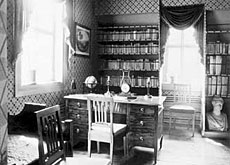Schiller and Tell – a winning combination

Friedrich Schiller痴 William Tell had its stage premiere exactly 200 years ago in the German town of Weimar. It brought the author acclaim and the legend world fame.
Schiller, who lived in Weimar, was given the title 鍍he poet of freedom� for the work. But why did he decide to write about Tell in the first place?
Schiller never visited central Switzerland where the Tell myth is inextricably linked to the story of the founding of the Swiss Confederation. In fact, the German playwright had no first-hand experience of Switzerland at all.
However, Schiller痴 wife, Charlotte, had spent some time as a young girl in this part of Switzerland. The landscape and the Tell legend left a lasting impression on her, as it did on Schiller痴 friend, Johann Wolfgang von Goethe.
Goethe had journeyed through the region on several occasions and had collected a lot of material relating to William Tell.
In 1797 Goethe wanted to retell the story in a poem, and he informed Schiller of his intentions.
He never got round to the project, but Schiller took up the idea a couple of years later, and quizzed his wife and his friend on Tell and Switzerland.
He began to read books and anything on the subject that fell into his hands, including the highly-regarded Swiss history, 鼎hronikon Helveticon�, by Aegidius Tschudi (1505-1572).
Tell wallpaper
He was so obsessed that he wallpapered his study with maps, pictures and drawings of central Switzerland.
He eventually became so knowledgeable about the story and its setting that even the Swiss he met were amazed at how accurately and colourfully he could describe the region.
Following his extensive research, Schiller was finally ready to start work on writing the epic drama in 1802. But illness and other tasks delayed him for a year.
He finally completed 展illiam Tell� on February 18, 1804, and he sought to hold the premiere in the German national theatre in Berlin.
However, the theatre director in Berlin was concerned that the piece could prove politically explosive. Schiller then turned to Weimar, where the play was finally shown two months later on March 17, under the direction of none other than Goethe.
Applause
Schiller clearly enjoyed seeing his version of the legend performed on stage.
A friend sitting beside Schiller said she could see the 屠oy written on his face, and how he responded to each successfully performed scene, and the applause�.
Schiller was apparently most taken with the reality of the apple-shooting scene.
But the premiere did come in for some criticism. One critic complained that 杜any in the audience did not judge it to be among Schiller痴 better works�.
History has not borne out the criticism. The last work Schiller would complete has proved to be one of the most successful and acclaimed plays of all time.
At the time of his death one year later, Schiller had become more popular than his friend Goethe.
swissinfo, Etienne Strebel
Schiller was born in 1759 in the German town of Marbach am Neckar.
His first drama was 典he Robbers� published in 1780.
Besides William Tell, his best-known works are 展allenstein�, 溺arie Stuart�, 典he maid of Orleans� and 典he bride of Messina�.
He died of tuberculosis in 1805.

JTI基準に準拠
swissinfo.chの記者との意見交換は、こちらからアクセスしてください。
他のトピックを議論したい、あるいは記事の誤記に関しては、japanese@swissinfo.ch までご連絡ください。